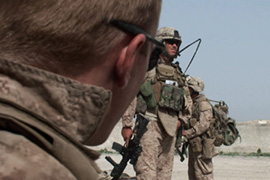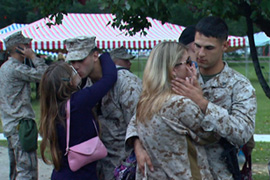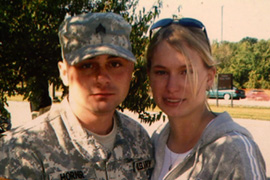The war within
Al Jazeera examines the issue of post-traumatic stress disorder in the US military.

Out of two million US soldiers who have served in Afghanistan and Iraq, psychiatrists estimate that one in three may, at some point, develop post-traumatic stress disorder (PTSD).
PTSD is a ticking time bomb with a decades-long fuse – a problem whose true magnitude is difficult to determine.
Keep reading
list of 4 itemsWoman, seeking loan, wheels corpse into Brazilian bank
UK set to ban tobacco sales for a ‘smoke-free’ generation. Will it work?
Poland lawmakers take steps towards liberalising abortion laws
After years of denial, the US army is only now coming to terms with how to address this problem.
The war within: PTSD in the military addresses the US army’s human resources dilemma and features the stories of those who have had to come to terms with the physical and psychological wounds suffered from fighting a war that is increasingly unpopular in their home country and around the world.
It is the story of five American soldiers stricken with PTSD. One is on trial for murder, two committed suicide and two others are still in the army, struggling to get treatment.
The war within: PTSD in the military aired from February 4, 2010.
| Interview with psychologist Barbara Van Dahlen |
To understand the symptoms and causes of PTSD from a medical perspective, Al Jazeera spoke to Barbara Van Dahlen, a clinical psychologist and the president and founder of Give An Hour (GAH), a nonprofit organisation that provides free mental health services to US military personnel and their families who have been affected by the conflicts in Iraq and Afghanistan.
Al Jazeera: What is PTSD?
| For MORE ON PTSD | |||||||||
|
Barbara Van Dahlen: Often if somebody feels anxious in general, when they’re in a crowd, in a grocery store, or in a large shopping mall, or in a restaurant where there’s a lot of noise, a lot of people become very anxious because they can’t scan the environment, they don’t feel safe.
For soldiers who have been involved in roadside bombs in Afghanistan and Iraq, their spouses will often report that they drive in the middle of the road, which is obviously very dangerous back here in the US. But they do that because the roadside bombs were often on the side of the roads and they won’t even recognise or realise that they’re drifting to the middle of the road, but you can see and hear how the brain is just scanning for a potential threat in the environment.
You’re on the alert because the fear is that there’s danger because people who have experienced trauma were hit by an event that they couldn’t control that was very either physically threatening, or disruptive, or dangerous, or all the above and so their brain is on hyper alert for fear that another attack or another event will occur that they can’t control.
Society has always known soldiers come back psychologically changed or even broken by war. Can you talk us through the changes over the years and the wars?
PTSD has always been part of the human condition. We just haven’t called it that until after the Vietnam War. But even when we look back at stories going back to the American Civil War and before, wars throughout eternity, there would be reports of how soldiers would respond.
I think after the Civil War they called it soldier’s heart. We called it shellshock, various sorts of names that indicated that the soldier was affected and wasn’t the same after his experience in combat.
[It is] not just with combat – people who are in car accidents, airplane crashes, any kind of jarring traumatic event, rape, being at the scene of a violent crime, leaves people with this aftershock that can stay with you for years, for the rest of your life, if it goes unaddressed.
What is different about the current wars in Iraq and Afghanistan?
We hear a lot about how because it is a different kind of war there is no frontline – it’s difficult to tell who is friend and who is foe.
I’ve talked to many soldiers and marines who come back and say they’re on alert for the entire 12 months that they’re there, and so that creates a higher sense of vigilance from the beginning.
People are jarred from the minute that they step foot there, there’s a sense of unease. And that’s different certainly from the Second World War and the First World War where there was a frontline, and people would go, and they would serve and they would come back and they would be in a relatively safe zone. There isn’t really a safe zone in these current wars.
Has the US government been up to the task of dealing with the number of PTSD cases?
 |
| The suicide rate among soldiers on active duty is at an all time high and rising |
In the beginning obviously the belief was that the war would be much shorter in duration, but because it has gone on for [so long] now, the sheer number of people who have been affected, and their families, really make it just impossible for the government, even if they were trying to do so from the beginning, which they were, because we knew to expect this.
But the numbers of people coming home is really making it very difficult to meet the need, which is why there are a number of organisations that have to step up to help.
This is a huge change in the American military culture.
Prior to this war, leaders would talk about these kinds of consequences to military personnel as sort of the casualties of war. That has changed so that now the leadership from the top – Admiral Mullen, the chairmen of the joint chiefs of staff, repeatedly comes out talking about this – [stresses the] importance of us taking care of these men and women, that we’re not doing enough, that we need to do better.
They are working internally at the Pentagon to change the culture. It’s a huge task to make this shift, but unlike any war before, the military leadership recognises this is an issue for fitness to serve. These folks can’t continue to serve if we don’t take care of them.
Also there’s a change in understanding [PTSD] – that it’s real, that it’s not just a soldier complaining and whining, that these are real phenomenon, it affects our brains. So yes, there’s a difference, and I’ve seen it over the last five years that I’ve been working on these issues with the military.
Is there something in the ‘warrior culture’ of soldiers that makes it hard for them to deal with PTSD?
Unfortunately, soldiers often feel like it’s a sign of weakness to say, “hey I’m struggling, I’m not feeling right, I’m having trouble sleeping, I’m anxious, I’m hyper vigilant” because the warrior mentality in our military and militaries throughout the world is to be tough. You suck it up, you go on, you don’t complain.
And also, there’s a sense of, I’ve got my buddy’s back, I need to be ready, I need to be on, and I want them to be ready.
We’re doing a lot of educating to explain that this isn’t a weakness, this doesn’t mean you can’t serve, it doesn’t mean you’re not effective as a soldier, but if you don’t address it you won’t be able to be there for your buddy.
But it’s a huge shift in the mentality, in the culture.
Who is affected by PTSD? Just the soldiers?
No, and this is one of the real issues in dealing with post traumatic stress. Not only is it the solider or marine who is exposed to combat who comes home, but their entire family.
We’ve even now coined a phrase – ‘secondary trauma’ – to refer to the phenomenon that family members who live with someone who has post-traumatic stress will start to develop symptoms themselves of post-traumatic stress if the person who has that condition is not treated.
So it affects spouses and children and anyone who spends a significant amount of time and who is close to the person who is dealing with this.
It has a huge ripple effect, and then, it goes beyond the nuclear family. Then it affects employers, it affects the educational system of GIs who are going back to the campuses of our country.
It has a huge ripple effect, which is why those of us working in this area really feel like it’s a public health crisis. We have to get in front of this.
How important is it to have rest time between deployments?
 |
| Post-traumatic stress disorder can affect soldiers and their families |
Well what we know is that people who are deployed more frequently are at a greater risk for developing post-traumatic stress. So if we allow people to come home and have some time at home, to reconnect with their families, return to life before combat, that’s important. That’s very very helpful, in some ways critical, in allowing them to process and let down.
But I’d say that more important than the time alone is the knowledge and awareness of what you’ve got to do with that time.
Some soldiers and marines come back and they don’t want to deal with that stuff so they’ll escape and avoid. In that case, having down time isn’t nearly as effective as somebody who recognises “alright, I’ve been through a lot and I need to clean out those parts of me that have been effected, I need to process it, I need to get some support for it” – then that down time, that dwell time, can be incredibly useful.
There are so many variables in terms of what an individual might need. We know that a month isn’t enough. Is a year enough? Again, it depends on what we’re doing during that year.
So the more programmes we put into place to educate soldiers so they know what to do when they come home, then I think we’ll get a better sense of what amount of time they need.
Obviously, the more time between deployments the better. If we’re limited because the force needs to be reengaged, then we have to make the most of the time they have off, but that’s why the military changed the policy about length deployment.
We knew that 15 months was too long, so getting people in and out as quickly as possible is also critical to allow them to reset, allow them to get out of that place where their constantly hyper vigilant state is really critical.
How much of a challenge will the new deployments to Afghanistan create in terms of treating PTSD?
For some of the families who have already experienced deployment two or three times this is exhausting. They’re exhausted. The families are exhausted, the service members are exhausted, so it continues to place an additional strain on an already exhausted fighting force.
We really need to do our job and educate and provide them with resources so that while they’re dealing with deployment, whether that is the family or the soldier, they have tools available to them, because for all people, if we have tools to help us deal, we can withstand a lot of stress.
Most of these people don’t have any idea what is going on. They don’t understand what has happened to them. They may hear of post-traumatic stress, but to really understand you either have to have it happen to you or to really pay attention when someone is explaining it to you so that you can emotionally grasp “oh that’s what could happen to me”.
People don’t really get the actual experience and so afterwards they’re left not really knowing what’s going on.
You’ll hear soldiers will say “I thought I was going crazy”. That’s a common one. You know “what’s wrong with me?” And then when you explain this is what happens when people are put in these situations, then it’s such a relief, “oh this is normal”. Yes, this is normal. You’re not crazy. Then they can start to deal with it more effectively.
Can PTSD be cured?
You will hear many people refer to how they manage it.
You’ll notice that I typically don’t say post-traumatic stress disorder because it doesn’t become a disorder unless we ignore it and don’t treat it.
If we deal with it, if we help people process – because this is a processing issue, it’s an assault to an individual’s psyche, the psychological part of us and the physiological part of us gets hyper-reactive, hyper-stimulated. So if we address it, if we help people process it and understand it, learn to address it, learn to cope with it, the symptoms are much less severe, much more manageable. But most people who have had severe post-traumatic stress will tell you that they live with it.
You know I have soldiers who I’m very close to that will go into a restaurant and say “you know I need to sit with my back to the wall”. They know that it’s irrational, but it makes them feel more at ease, so why not?
So managing it, avoiding situations that are going to trigger strong reactions, all of those things are critical, but it doesn’t mean that it has to be disabling.
But we know from studies that the earlier we get in, the earlier we help people respond to the experience they’re having, the less likely it is that they’ll have severe symptoms.
How big of a risk is suicide for people who suffer from PTSD?
 |
| Nicholas Horner is an Iraq war veteran charged with murdering two people in April 2009 |
Well, we know it’s a risk factor for suicide; people who have post-traumatic stress are at higher risk for suicidal ideation.
They become more anxious, agitated, and when you are in that psychological state of mind, where the world really doesn’t feel safe and you feel frightened and threatened, you’re not making the best decisions, your judgment is impaired. So that puts you at a higher risk for impulsive acts.
Many of the soldiers and marines who committed suicide didn’t have a history of depression or anxiety that would suggest that they would be at high risk for suicide. What does that tell us? It’s the circumstances they’re in. And so if we can get them through that period of time it’s unlikely that they’ll be at high risk because that’s not their history.
I mean, there are some people who commit suicide, you look back and they had a long history of depression and suicide attempts. Many of these men and women who commit suicide in the military, I mean, this was an impulsive act. And luckily I know many soldiers who are alive today who tell me “I sat on my bed with my gun in my lap contemplating whether I was going to end it”. Now obviously the fact that they’re telling me means they’re still here today. But many, many more that actually commit suicide are contemplating suicide, and that is a very scary reality right now.
Can you describe your organisation, Give An Hour?
Given An Hour is a nonprofit that provides free mental health care to the troops and their families. I founded it almost five years ago. I knew that we in the mental health field knew a lot more about issues like post-traumatic stress, traumatic brain injury, but that if there weren’t enough of us stepping up to help, that there was going to be a huge number of folks who weren’t treated.
So that’s why I had the idea to ask mental health professionals to give an hour of their time a week.
I’m not surprised, but very pleased that the mental health community has really embraced this idea, and we now have nearly 4,700 mental health professionals throughout the country.
We found that in addition to giving the direct care – the counselling, the therapy for those who are affected – we’re also now educating communities. We’re consulting to other nonprofits. So a nonprofit that maybe helps with employment, they’re recognising that the mental health issue here is significant, so we come in as the mental health team, the mental health expert, to educate, to explain to everybody what they can expect with folks coming back.
It has really been an honour to build this organisation because people wanted to give, they wanted to help and we just needed to find a way for them to do it, and now we know it’s critical that the nonprofit community step up to respond to the military because the military, the government, whether it’s the department of defence or the department of veterans affairs, cannot do it alone, and personally, I don’t think that they should.
This is our country involved in these wars, it’s not just a department of defence war. So, it’s important for all of us to do our part. It’s good for us, it’s good for those who serve, so it’s a process in development. But there are doors opening to develop these really nice collaborative efforts with the department of defence and the department of veterans affairs.
